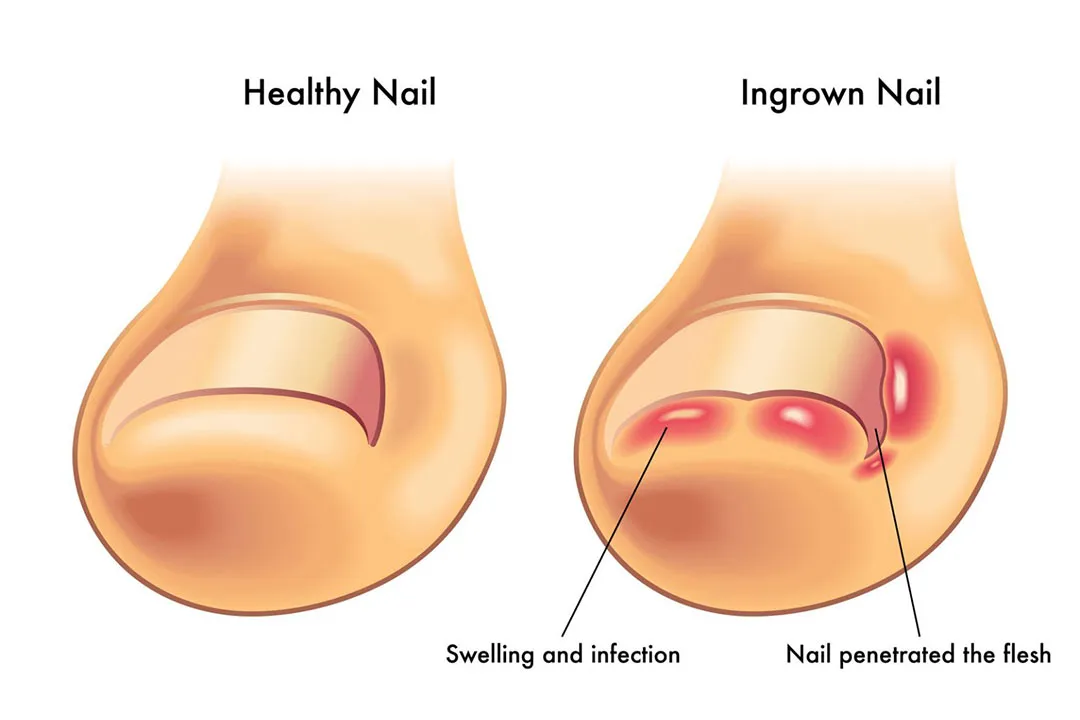An ingrown toenail, though small in size, can cause significant discomfort and pain. This common condition occurs when the edge of the toenail grows into the surrounding skin, leading to redness, swelling, and often infection. While ingrown toenails can be a nuisance, understanding the causes, symptoms, and treatment options can help manage and prevent this pesky problem.
Causes and Risk Factors
Several factors can contribute to the development of ingrown toenails:
- Improper Trimming: Cutting toenails too short or not straight across can encourage the nail to grow into the skin.
- Ill-Fitting Shoes: Tight shoes or high heels can exert pressure on the toes, pushing the skin into the nail.
- Injury: Stubbing your toe or other trauma can lead to ingrown toenails.
- Genetics: Some people may inherit a tendency for their toenails to curve inward.
- Poor Foot Hygiene: Not keeping feet clean and dry can increase the risk of infection.
Symptoms
The signs of an ingrown toenail are usually straightforward:
- Pain: The affected toe can be tender and sore.
- Redness and Swelling: The skin around the ingrown toenail may become inflamed.
- Infection: If left untreated, an ingrown toenail can lead to an infection, characterized by pus and drainage.
Treatment Options
Treatment for ingrown toenails depends on the severity of the condition. Here are some common approaches:
- Soak Your Foot: Soaking your foot in warm, soapy water several times a day can help reduce swelling and tenderness.
- Trim Nails Properly: Trim your toenails straight across and avoid cutting them too short.
- Wear Proper Footwear: Opt for shoes that provide enough room for your toes and avoid tight-fitting footwear.
- Medication: Over-the-counter pain relievers and anti-inflammatory drugs can help manage pain and reduce inflammation.
- Professional Care: In severe cases, a podiatrist may need to trim or remove the ingrown portion of the nail. They may also prescribe antibiotics if there is an infection.
- Onyfix Treatment: Onyfix is a non-invasive treatment option for ingrown toenails. It involves applying a flexible, resin-based strip to the affected nail. This strip gently lifts the edges of the nail, allowing it to grow outwards instead of into the skin. Onyfix can be a useful option for mild to moderate cases of ingrown toenails, providing relief without the need for surgery.
Prevention Tips
Taking preventive measures can reduce the risk of developing ingrown toenails:
- Proper Nail Care: Trim your toenails straight across and avoid rounding the edges.
- Footwear: Wear shoes that fit properly and provide enough room for your toes.
- Foot Hygiene: Keep your feet clean and dry to prevent bacterial growth.
- Regular Check-ups: If you are prone to ingrown toenails, regular visits to a podiatrist can help prevent future issues.
When to See a Doctor
If you have diabetes, poor circulation, or nerve damage in your feet, it’s crucial to see a doctor at the first sign of an ingrown toenail. Additionally, if you have recurring ingrown toenails or signs of infection, such as pus or redness spreading, seek medical attention promptly.
In conclusion, while ingrown toenails are a common and often painful condition, they can be managed and prevented with proper care. By understanding the causes, symptoms, and treatment options, you can take steps to keep your feet healthy and free from discomfort. If you’re experiencing persistent or severe symptoms, consult a healthcare professional for guidance tailored to your situation, including the potential use of Onyfix.
Our doctors at Stepping Stone Foot & Ankle Specialists can help determine which of the above treatment option is best for you. Please contact our office to schedule an appointment today. Call us at (610) 672-8988 for a consultation or email us at info@steppingstonefootankle.com.
If you want to learn more about this condition or treatment options, please visit our website at www.SteppingStoneFootAnkle.com or Follow Us on our Facebook and Instagram pages.

